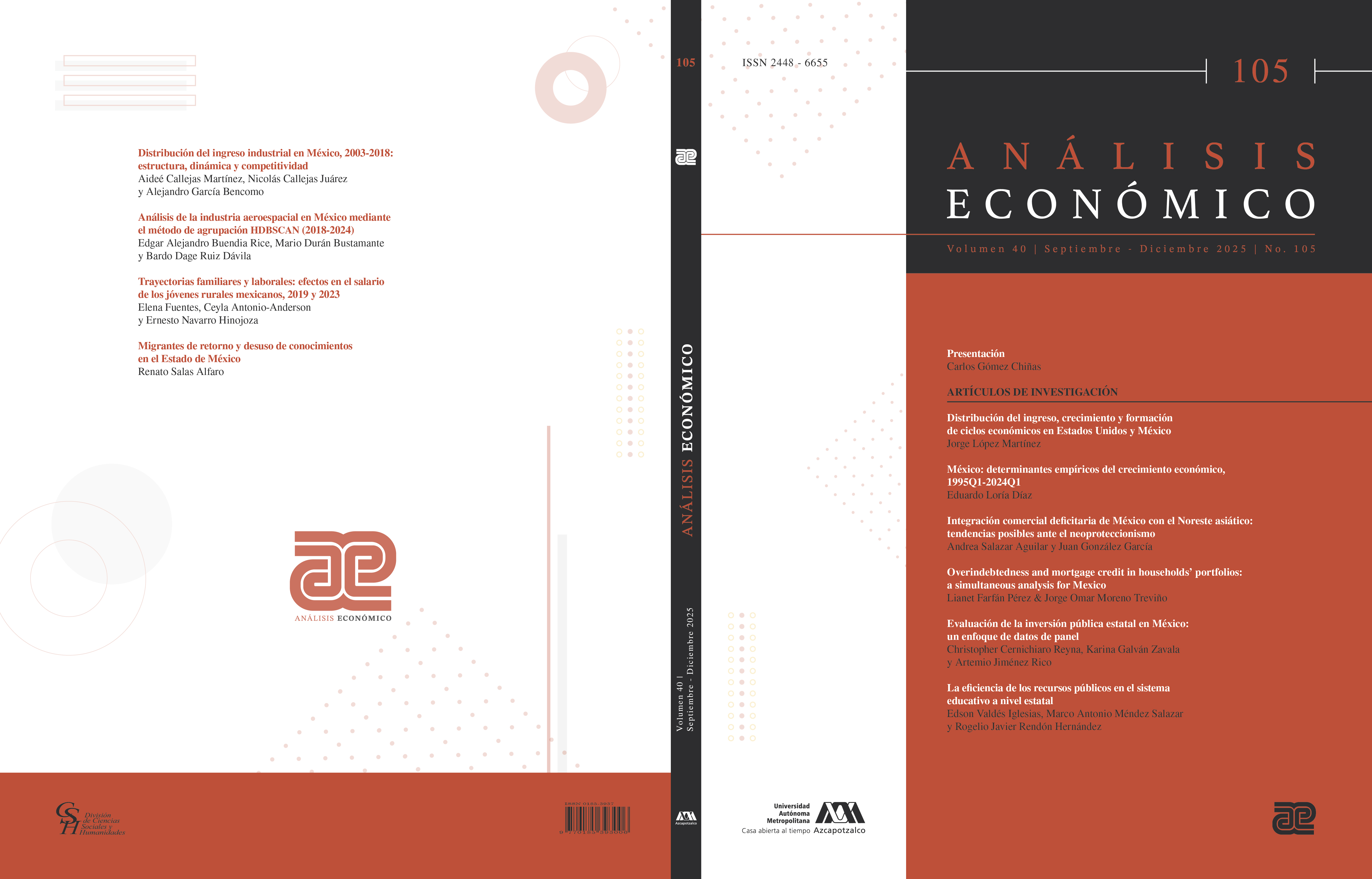Distribution of industrial income in Mexico, 2003-2018: structure, dynamics and competitiveness
Keywords:
Gini coefficient, Industrial concentration, Industrial location, Industrial specialization, Industrial restructuringAbstract
The Gini Coefficient (GC) was used to study the distribution of Mexico's industrial income and through the theory of localization, its structure, dynamics and competitiveness during the period 2003 to 2018 were detailed. The distribution of industrial income is influenced by firm size and geographic location. It was found that CG varied between states and firm size (p<0.05), but not between micro-small, medium-large firms and between five-year periods (p > 0.05). In Mexico, industry diversified, with greater specialization in micro firms and broader diversification in large firms. The restructuring and relocation
of companies has facilitated their economic expansion, and the Gini coefficient is expected to continue to improve
JEL Classification: D22, D31, L6, L74, O15
Downloads
References
Alesina, A., & Rodrik, D. (1994). Distributive politics and economic growth. The Quarterly Journal of Economics, 109(2), 465–490. https://doi.org/10.2307/2118470
Barro, R. J. (2000). Inequality and Growth in a Panel of Countries. Journal of Economic Growth, 5(1), 5–32. https://doi.org/10.1023/a:1009850119329
Benedetti, Y., Morelli, F., Callaghan, C. T., Fuller, R., & Sheard, C. (2022). Distribution and protection of avian specialization in Europe. Global Ecology and Biogeography: A Journal of Macroecology, 31(1), 10–24. https://doi.org/10.1111/geb.13405
Bustos, V. y A. Romo. (2022). Seguimiento de la distribución del ingreso en México a lo largo del tiempo y de la geografía. Revista Internacional de Estadística y Geografía, 13(3): 28-49.
Cosic, D. (2018). La distribución salarial y su relación con el tamaño de la empresa. El caso de los Estados Unidos. Revista internacional del trabajo, 137(3), 397–419. https://doi.org/10.1111/ilrs.12094
INEGI. De establecimientos en nuestro país. 2020. Estadísticas a propósito del día de las micro, pequeñas y medianas empresas (27 de junio) datos nacionales. Org.mx. Recuperado el 3 de julio de 2025, de https://www.inegi.org.mx/contenidos/saladeprensa/aproposito/2020/MYPIMES20.pdf
Fajnzylber, P., Lederman, D., & Loayza, N. (2002). Inequality and Violent Crime. The journal of law & economics, 45(1), 1–39. https://doi.org/10.1086/338347
Fedderke, J., y Naumann, D. (2011). Un análisis de la concentración industrial en la industria manufacturera sudafricana, 1972-2001. Applied Economics, 43, 2919-2939. https://doi.org/10.1080/00036840802631835
Galindo Pérez, M. C., Pérez Campuzano, E., y Suárez Lastra, M. (2020). Movilidad intrarregional en la región Centro de México, 2000-2015. Investigaciones Geográficas, 102. https://doi.org/10.14350/rig.60093
Gao, B., & Qiu, B. (2023). Income distribution and unequal gains from trade. World Economy, 46(1), 236–255. https://doi.org/10.1111/twec.13271
González Gutiérrez, J. (2023). La distribución del ingreso en México (2008-2020). Revista de Economía, 40(100). https://doi.org/10.33937/reveco.2023.305
Hernández-Castellanos, A. A., Mapén-Franco, F. de J., & Hernández-Govea, L. M. (2021). Digital economy: Overview of income taxation in Mexico. Revista científica de la UCSA, 8(2), 51–63. https://doi.org/10.18004/ucsa/2409-8752/2021.008.02.051
Jacobs, L., Llanes, E., Moore, K., Thompson, J., & Volz, A. H. (2022). Wealth concentration in the USA using an expanded measure of net worth. Oxford Economic Papers, 74(3), 623–642. https://doi.org/10.1093/oep/gpab054
Kharazmi, E., Bordbar, N., & Bordbar, S. (2023). Distribution of nursing workforce in the world using Gini coefficient. BMC Nursing, 22(1), 151. https://doi.org/10.1186/s12912-023-01313-w
Kjelsson, G., & Petrie, D. (2021). Visualizing the evolution of income inequality. Journal of income distribution. https://doi.org/10.25071/1874-6322.40391
Krugman, P. R. (1993). On the relationship between trade theory and location theory. Review of International Economics, 1(2), 110–122. https://doi.org/10.1111/j.1467-9396.1993.tb00009.x
Lira, L. y Quiroga, B. (2009). Técnicas de Análisis Regional. UN-ECLAC. https://hdl.handle.net/11362/5500
Lustig, N. (2020). Desigualdad y descontento social en América Latina. Nueva sociedad, 286, 53–61. https://www.mendeley.com/catalogue/aae8ecbc-9e6f-3fd1-8acf-a7900006caa2
Melitz, M. J. (2003). The impact of trade on intra-industry reallocations and aggregate industry productivity. Econometrica: Journal of the Econometric Society, 71(6), 1695–1725. https://doi.org/10.1111/1468-0262.00467
Ocegueda Hernández, J. M., Castillo Ponce, R. A., y Varela Llamas, R. (2010). Crecimiento regional en México: Especialización y sectores clave. Problemas del desarrollo, 40(159), 61-84. https://doi.org/10.22201/iiec.20078951e.2009.159.14677
Pedraza, J. M. (2021). The micro, small, and medium-sized enterprises and its role in the economic development of a country. Business and management research, 10(1), 33. https://doi.org/10.5430/bmr.v10n1p33
Prawoto, N., & Cahyani, R. D. (2020). Analysis of unequal distribution of population income in Indonesia. Journal of Asian Finance Economics and Business, 7(7), 489–495. https://doi.org/10.13106/jafeb.2020.vol7.no7.489
Quispe Llanos, R. (2021). La Distribución del Ingreso en el Perú, 1996-199. Revista IECOS, 1, 58–70. https://doi.org/10.21754/iecos.v1i0.1115
Rendón-Morquecho, J., y Marroquín-Arreola, J. (2020). Desigualdad del ingreso y su impacto en el crecimiento económico por entidad federativa en México. Revista de ciencias sociales, (168), 47–60. https://doi.org/10.15517/rcs.v0i168.43970
Rey, S. J., & Casimiro Vieyra, E. (2023). Spatial inequality and place mobility in Mexico: 2000–2015. Applied Geography, 152(102871), 102871. https://doi.org/10.1016/j.apgeog.2023.102871
Rogerson, P. A. (2013). The Gini coefficient of inequality: a new interpretation. Letters in Spatial and Resource Sciences, 6(3), 109–120. https://doi.org/10.1007/s12076-013-0091-x
Saraví, G. (2019). La Desigualdad Social en América Latina. Encartes, 2(4), 70–87. https://doi.org/10.29340/en.v2n4.113
Statista Research Department. La industria manufacturera en México – Datos estadísticos. (s/f). Statista. Recuperado el 12 de mayo de 2024, de https://es.statista.com/temas/7853/la-industria-manufactureraen-mexico/
Wilcox, E., Levy, R., Morita, T., & Futrell, R. (2018). What do RNN language models learn about filler–gap dependencies? Proceedings of the 2018 EMNLP Workshop BlackboxNLP: Analyzing and Interpreting Neural Networks for NLP.
Yan, X., & Mohd, S. (2023). Trends and causes of regional income inequality in China. Sustainability, 15(9), 7673. https://doi.org/10.3390/su15097673
Yang, Y. (2009). Aglomeración y especialización industrial interurbana: un análisis empírico basado en las industrias manufactureras de Guangdong entre 1998 y 2007. International Economics and Trade Research.
Zheng, X., y Liu, Z. (2010). Un estudio sobre el impacto de la concentración industrial en el crecimiento económico basado en el análisis del coeficiente de Gini de las regiones de construcción. Applied Mechanics and Materials, 29-32, 2703 - 2708. https://doi.org/10.4028/www.scientific.net/AMM.29-32.2703
Downloads
Published
Issue
Section
License
Copyright (c) 2025 Nicolás Callejas, Aideé Callejas, Alejandro Garcia

This work is licensed under a Creative Commons Attribution-NonCommercial-NoDerivatives 4.0 International License.



